Business Environment: Organizational Types & UK Supermarket Analysis
VerifiedAdded on 2024/06/04
|22
|4444
|459
Essay
AI Summary
This assignment provides a comprehensive analysis of different types of organizations, including profit, not-for-profit, and non-governmental organizations, categorized by profit generation and size. It examines the characteristics of micro, small, medium, and large enterprises, highlighting their market share, profit share, growth, and sustainability. The assignment also delves into organizational structures like functional, divisional, matrix, and flat structures, discussing their complexities in transnational, international, and global contexts. A case study of the UK supermarket sector, focusing on Tesco and Oxfam, is presented using PESTEL and SWOT analyses to identify macro-environmental impacts, strengths, and weaknesses within the retail industry. The relationship between internal strengths/weaknesses and external macro factors is also explored, providing a holistic view of the business environment and organizational functions. Desklib offers this assignment as a resource for students, alongside a wealth of other study materials and AI-powered tools.
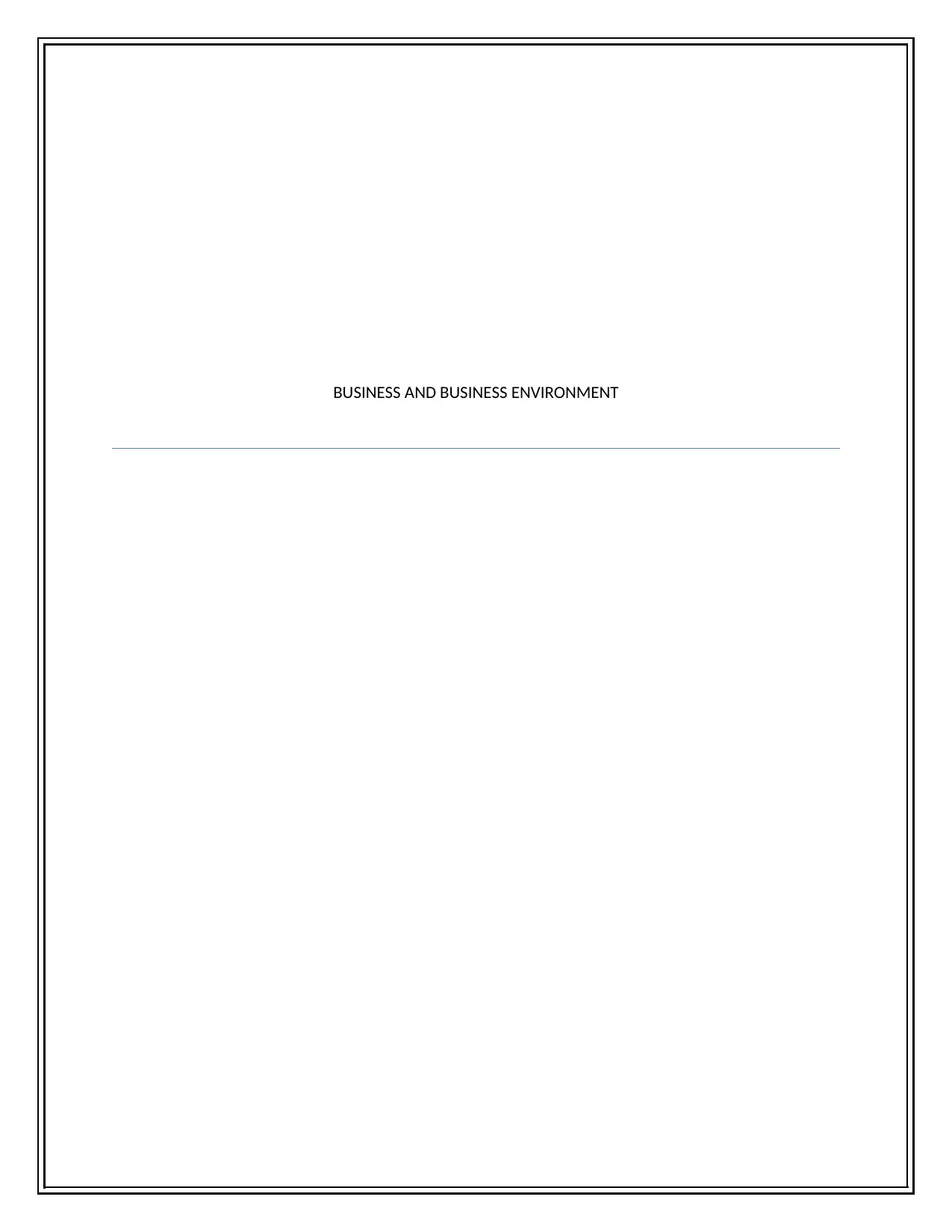
BUSINESS AND BUSINESS ENVIRONMENT
Paraphrase This Document
Need a fresh take? Get an instant paraphrase of this document with our AI Paraphraser
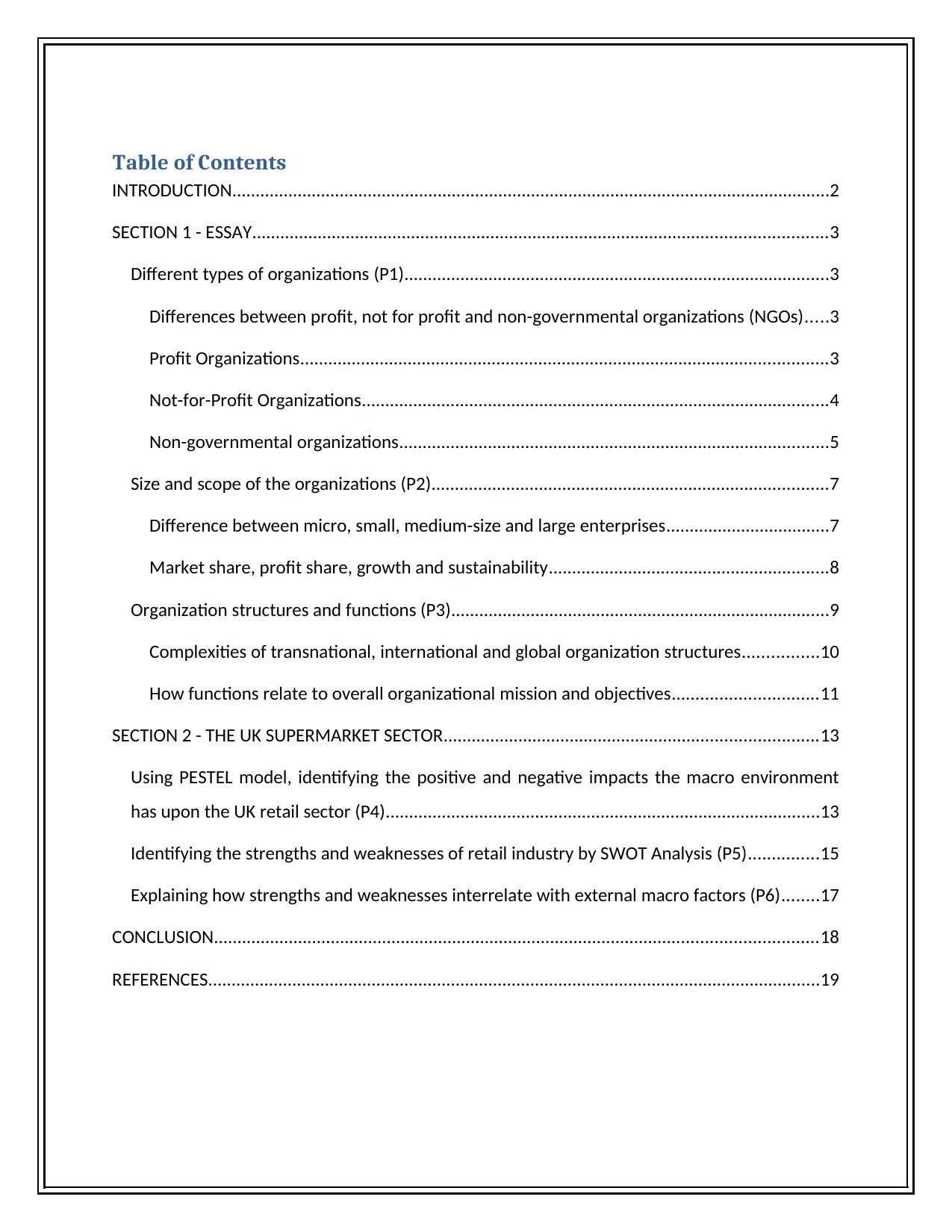
Table of Contents
INTRODUCTION................................................................................................................................2
SECTION 1 - ESSAY...........................................................................................................................3
Different types of organizations (P1)...........................................................................................3
Differences between profit, not for profit and non-governmental organizations (NGOs).....3
Profit Organizations.................................................................................................................3
Not-for-Profit Organizations....................................................................................................4
Non-governmental organizations............................................................................................5
Size and scope of the organizations (P2).....................................................................................7
Difference between micro, small, medium-size and large enterprises...................................7
Market share, profit share, growth and sustainability............................................................8
Organization structures and functions (P3).................................................................................9
Complexities of transnational, international and global organization structures................10
How functions relate to overall organizational mission and objectives...............................11
SECTION 2 - THE UK SUPERMARKET SECTOR................................................................................13
Using PESTEL model, identifying the positive and negative impacts the macro environment
has upon the UK retail sector (P4).............................................................................................13
Identifying the strengths and weaknesses of retail industry by SWOT Analysis (P5)...............15
Explaining how strengths and weaknesses interrelate with external macro factors (P6)........17
CONCLUSION.................................................................................................................................18
REFERENCES...................................................................................................................................19
INTRODUCTION................................................................................................................................2
SECTION 1 - ESSAY...........................................................................................................................3
Different types of organizations (P1)...........................................................................................3
Differences between profit, not for profit and non-governmental organizations (NGOs).....3
Profit Organizations.................................................................................................................3
Not-for-Profit Organizations....................................................................................................4
Non-governmental organizations............................................................................................5
Size and scope of the organizations (P2).....................................................................................7
Difference between micro, small, medium-size and large enterprises...................................7
Market share, profit share, growth and sustainability............................................................8
Organization structures and functions (P3).................................................................................9
Complexities of transnational, international and global organization structures................10
How functions relate to overall organizational mission and objectives...............................11
SECTION 2 - THE UK SUPERMARKET SECTOR................................................................................13
Using PESTEL model, identifying the positive and negative impacts the macro environment
has upon the UK retail sector (P4).............................................................................................13
Identifying the strengths and weaknesses of retail industry by SWOT Analysis (P5)...............15
Explaining how strengths and weaknesses interrelate with external macro factors (P6)........17
CONCLUSION.................................................................................................................................18
REFERENCES...................................................................................................................................19
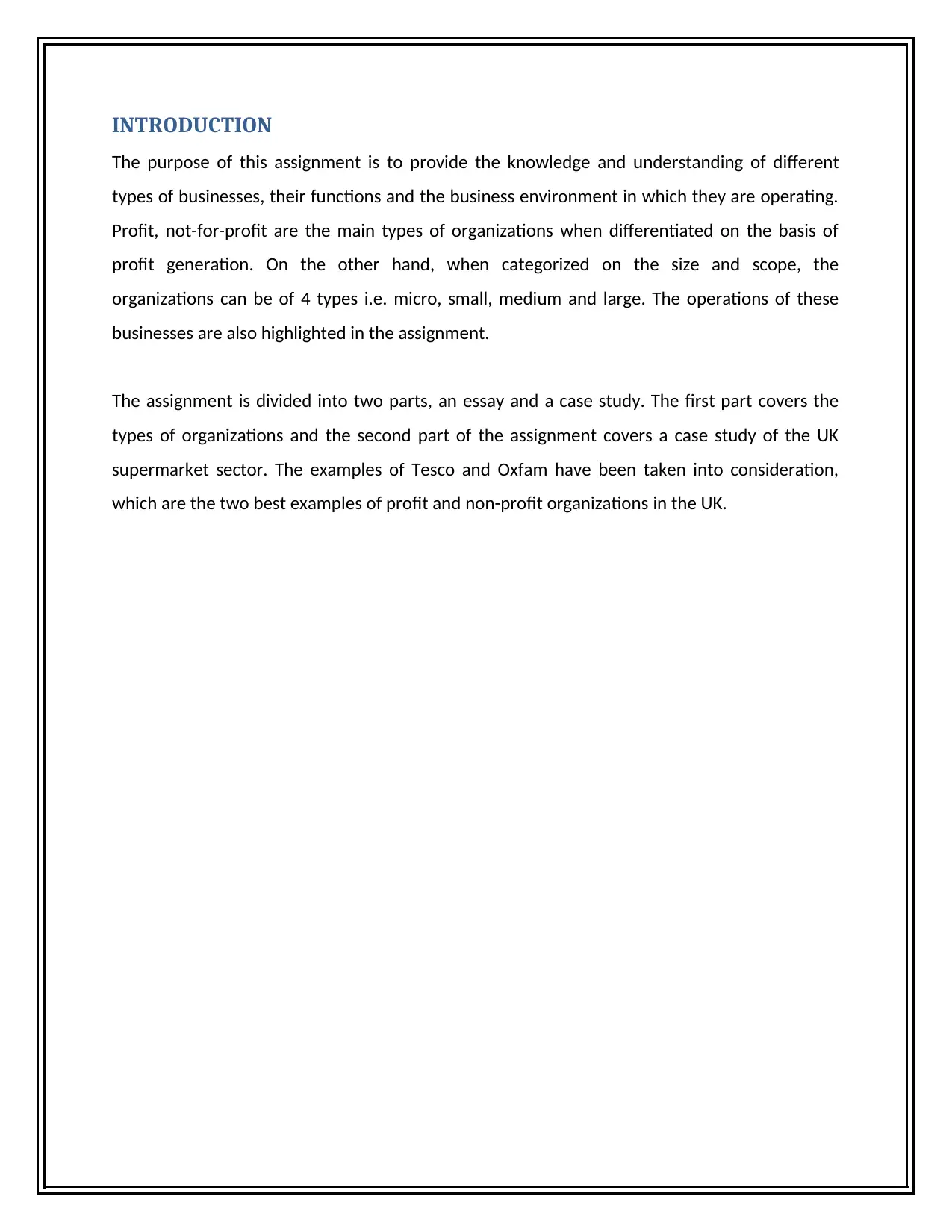
INTRODUCTION
The purpose of this assignment is to provide the knowledge and understanding of different
types of businesses, their functions and the business environment in which they are operating.
Profit, not-for-profit are the main types of organizations when differentiated on the basis of
profit generation. On the other hand, when categorized on the size and scope, the
organizations can be of 4 types i.e. micro, small, medium and large. The operations of these
businesses are also highlighted in the assignment.
The assignment is divided into two parts, an essay and a case study. The first part covers the
types of organizations and the second part of the assignment covers a case study of the UK
supermarket sector. The examples of Tesco and Oxfam have been taken into consideration,
which are the two best examples of profit and non-profit organizations in the UK.
The purpose of this assignment is to provide the knowledge and understanding of different
types of businesses, their functions and the business environment in which they are operating.
Profit, not-for-profit are the main types of organizations when differentiated on the basis of
profit generation. On the other hand, when categorized on the size and scope, the
organizations can be of 4 types i.e. micro, small, medium and large. The operations of these
businesses are also highlighted in the assignment.
The assignment is divided into two parts, an essay and a case study. The first part covers the
types of organizations and the second part of the assignment covers a case study of the UK
supermarket sector. The examples of Tesco and Oxfam have been taken into consideration,
which are the two best examples of profit and non-profit organizations in the UK.
⊘ This is a preview!⊘
Do you want full access?
Subscribe today to unlock all pages.

Trusted by 1+ million students worldwide
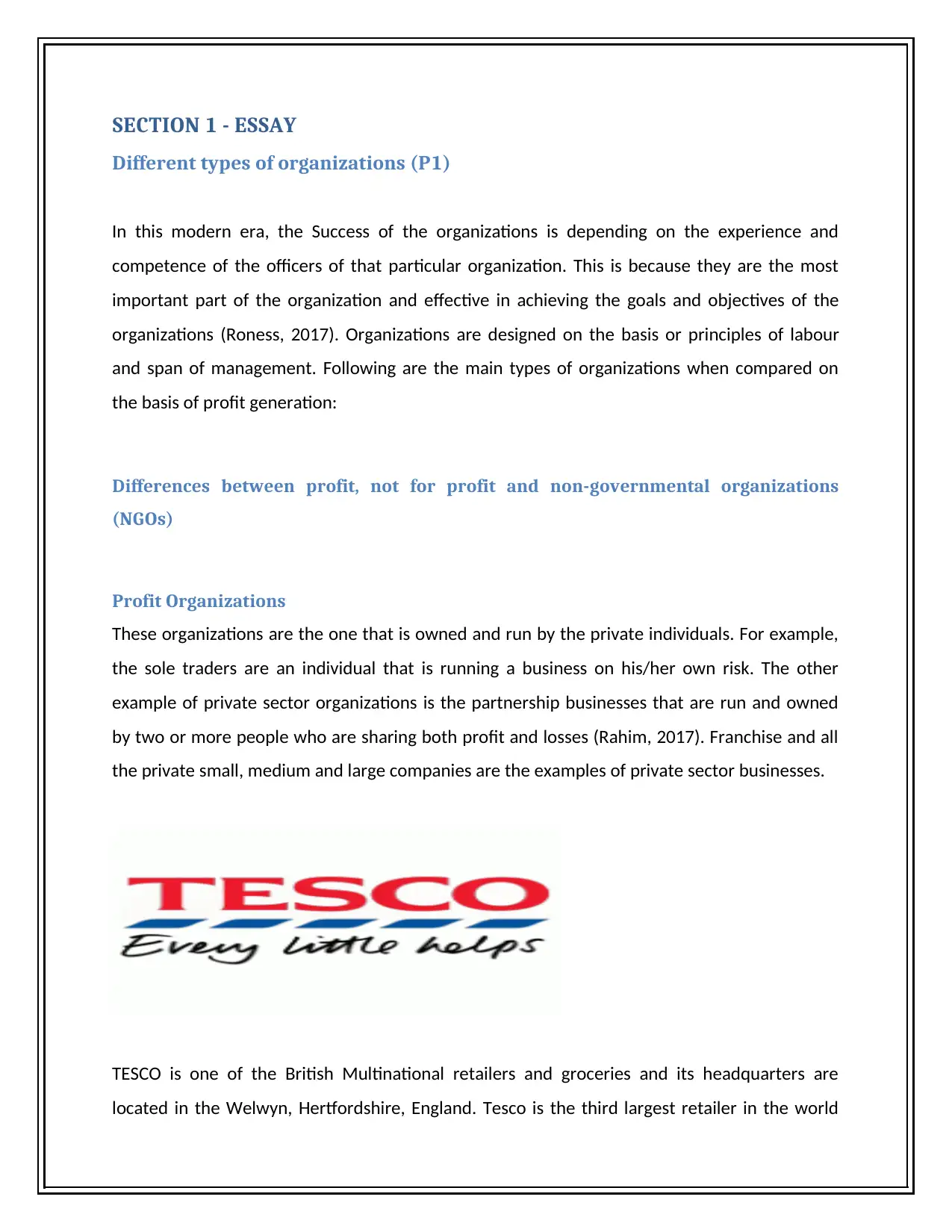
SECTION 1 - ESSAY
Different types of organizations (P1)
In this modern era, the Success of the organizations is depending on the experience and
competence of the officers of that particular organization. This is because they are the most
important part of the organization and effective in achieving the goals and objectives of the
organizations (Roness, 2017). Organizations are designed on the basis or principles of labour
and span of management. Following are the main types of organizations when compared on
the basis of profit generation:
Differences between profit, not for profit and non-governmental organizations
(NGOs)
Profit Organizations
These organizations are the one that is owned and run by the private individuals. For example,
the sole traders are an individual that is running a business on his/her own risk. The other
example of private sector organizations is the partnership businesses that are run and owned
by two or more people who are sharing both profit and losses (Rahim, 2017). Franchise and all
the private small, medium and large companies are the examples of private sector businesses.
TESCO is one of the British Multinational retailers and groceries and its headquarters are
located in the Welwyn, Hertfordshire, England. Tesco is the third largest retailer in the world
Different types of organizations (P1)
In this modern era, the Success of the organizations is depending on the experience and
competence of the officers of that particular organization. This is because they are the most
important part of the organization and effective in achieving the goals and objectives of the
organizations (Roness, 2017). Organizations are designed on the basis or principles of labour
and span of management. Following are the main types of organizations when compared on
the basis of profit generation:
Differences between profit, not for profit and non-governmental organizations
(NGOs)
Profit Organizations
These organizations are the one that is owned and run by the private individuals. For example,
the sole traders are an individual that is running a business on his/her own risk. The other
example of private sector organizations is the partnership businesses that are run and owned
by two or more people who are sharing both profit and losses (Rahim, 2017). Franchise and all
the private small, medium and large companies are the examples of private sector businesses.
TESCO is one of the British Multinational retailers and groceries and its headquarters are
located in the Welwyn, Hertfordshire, England. Tesco is the third largest retailer in the world
Paraphrase This Document
Need a fresh take? Get an instant paraphrase of this document with our AI Paraphraser
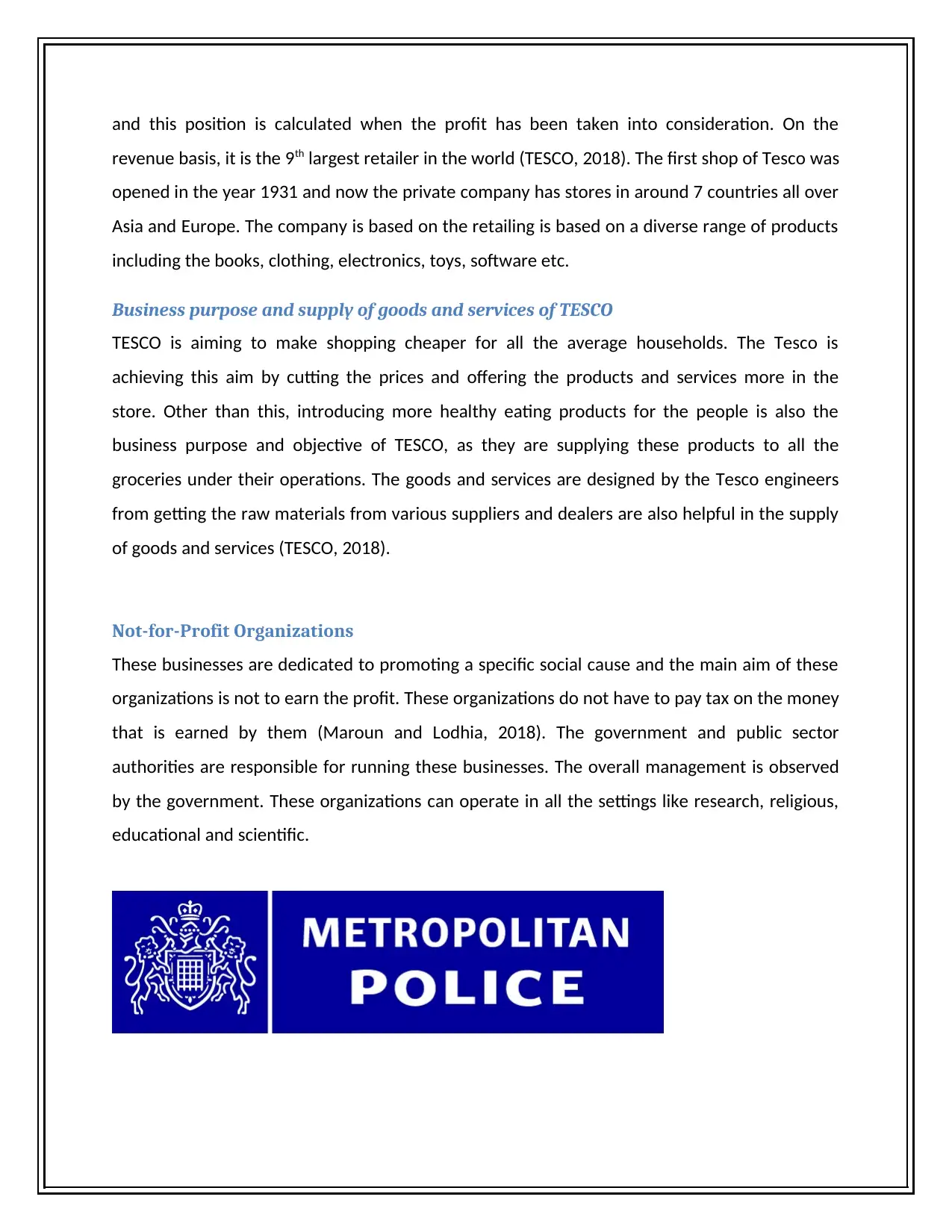
and this position is calculated when the profit has been taken into consideration. On the
revenue basis, it is the 9th largest retailer in the world (TESCO, 2018). The first shop of Tesco was
opened in the year 1931 and now the private company has stores in around 7 countries all over
Asia and Europe. The company is based on the retailing is based on a diverse range of products
including the books, clothing, electronics, toys, software etc.
Business purpose and supply of goods and services of TESCO
TESCO is aiming to make shopping cheaper for all the average households. The Tesco is
achieving this aim by cutting the prices and offering the products and services more in the
store. Other than this, introducing more healthy eating products for the people is also the
business purpose and objective of TESCO, as they are supplying these products to all the
groceries under their operations. The goods and services are designed by the Tesco engineers
from getting the raw materials from various suppliers and dealers are also helpful in the supply
of goods and services (TESCO, 2018).
Not-for-Profit Organizations
These businesses are dedicated to promoting a specific social cause and the main aim of these
organizations is not to earn the profit. These organizations do not have to pay tax on the money
that is earned by them (Maroun and Lodhia, 2018). The government and public sector
authorities are responsible for running these businesses. The overall management is observed
by the government. These organizations can operate in all the settings like research, religious,
educational and scientific.
revenue basis, it is the 9th largest retailer in the world (TESCO, 2018). The first shop of Tesco was
opened in the year 1931 and now the private company has stores in around 7 countries all over
Asia and Europe. The company is based on the retailing is based on a diverse range of products
including the books, clothing, electronics, toys, software etc.
Business purpose and supply of goods and services of TESCO
TESCO is aiming to make shopping cheaper for all the average households. The Tesco is
achieving this aim by cutting the prices and offering the products and services more in the
store. Other than this, introducing more healthy eating products for the people is also the
business purpose and objective of TESCO, as they are supplying these products to all the
groceries under their operations. The goods and services are designed by the Tesco engineers
from getting the raw materials from various suppliers and dealers are also helpful in the supply
of goods and services (TESCO, 2018).
Not-for-Profit Organizations
These businesses are dedicated to promoting a specific social cause and the main aim of these
organizations is not to earn the profit. These organizations do not have to pay tax on the money
that is earned by them (Maroun and Lodhia, 2018). The government and public sector
authorities are responsible for running these businesses. The overall management is observed
by the government. These organizations can operate in all the settings like research, religious,
educational and scientific.
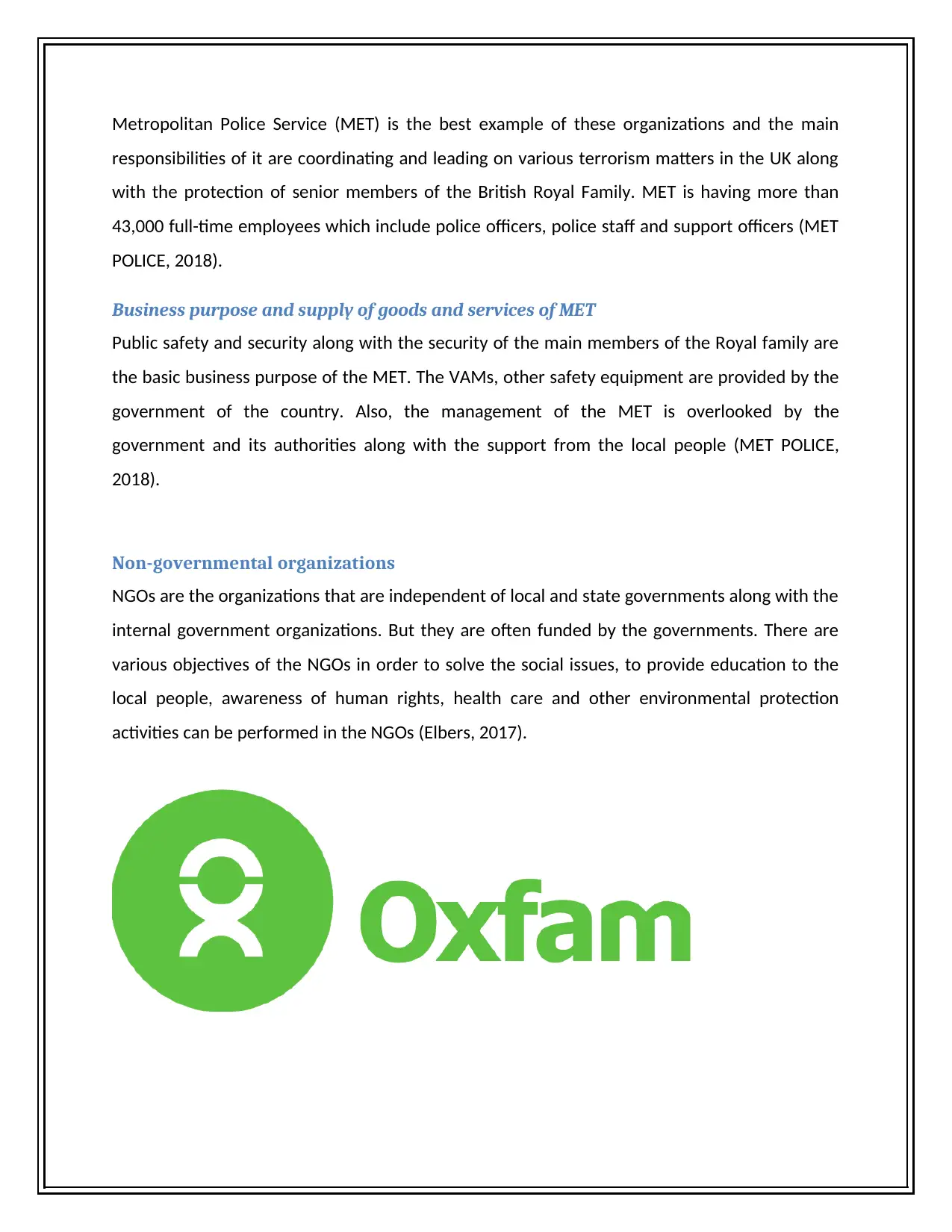
Metropolitan Police Service (MET) is the best example of these organizations and the main
responsibilities of it are coordinating and leading on various terrorism matters in the UK along
with the protection of senior members of the British Royal Family. MET is having more than
43,000 full-time employees which include police officers, police staff and support officers (MET
POLICE, 2018).
Business purpose and supply of goods and services of MET
Public safety and security along with the security of the main members of the Royal family are
the basic business purpose of the MET. The VAMs, other safety equipment are provided by the
government of the country. Also, the management of the MET is overlooked by the
government and its authorities along with the support from the local people (MET POLICE,
2018).
Non-governmental organizations
NGOs are the organizations that are independent of local and state governments along with the
internal government organizations. But they are often funded by the governments. There are
various objectives of the NGOs in order to solve the social issues, to provide education to the
local people, awareness of human rights, health care and other environmental protection
activities can be performed in the NGOs (Elbers, 2017).
responsibilities of it are coordinating and leading on various terrorism matters in the UK along
with the protection of senior members of the British Royal Family. MET is having more than
43,000 full-time employees which include police officers, police staff and support officers (MET
POLICE, 2018).
Business purpose and supply of goods and services of MET
Public safety and security along with the security of the main members of the Royal family are
the basic business purpose of the MET. The VAMs, other safety equipment are provided by the
government of the country. Also, the management of the MET is overlooked by the
government and its authorities along with the support from the local people (MET POLICE,
2018).
Non-governmental organizations
NGOs are the organizations that are independent of local and state governments along with the
internal government organizations. But they are often funded by the governments. There are
various objectives of the NGOs in order to solve the social issues, to provide education to the
local people, awareness of human rights, health care and other environmental protection
activities can be performed in the NGOs (Elbers, 2017).
⊘ This is a preview!⊘
Do you want full access?
Subscribe today to unlock all pages.

Trusted by 1+ million students worldwide
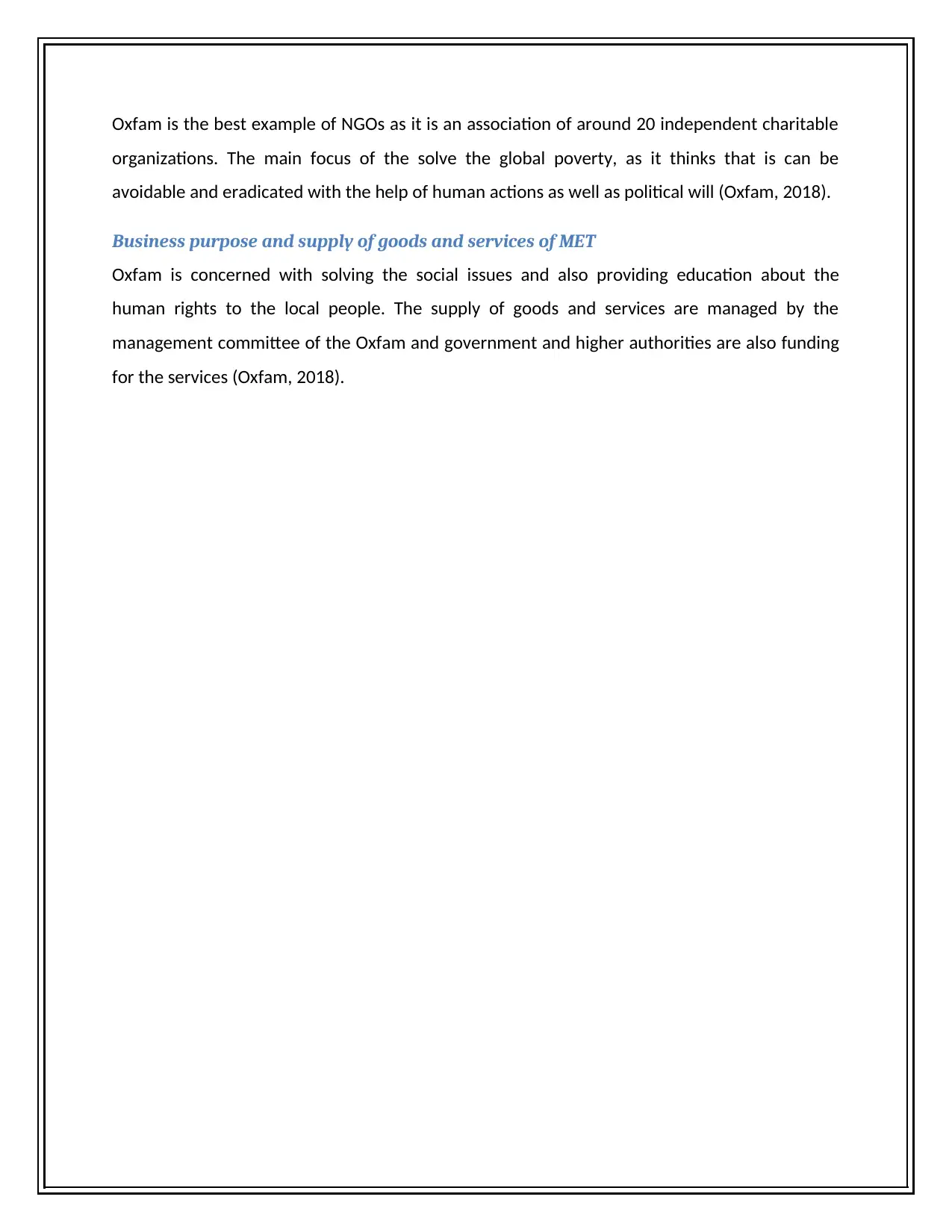
Oxfam is the best example of NGOs as it is an association of around 20 independent charitable
organizations. The main focus of the solve the global poverty, as it thinks that is can be
avoidable and eradicated with the help of human actions as well as political will (Oxfam, 2018).
Business purpose and supply of goods and services of MET
Oxfam is concerned with solving the social issues and also providing education about the
human rights to the local people. The supply of goods and services are managed by the
management committee of the Oxfam and government and higher authorities are also funding
for the services (Oxfam, 2018).
organizations. The main focus of the solve the global poverty, as it thinks that is can be
avoidable and eradicated with the help of human actions as well as political will (Oxfam, 2018).
Business purpose and supply of goods and services of MET
Oxfam is concerned with solving the social issues and also providing education about the
human rights to the local people. The supply of goods and services are managed by the
management committee of the Oxfam and government and higher authorities are also funding
for the services (Oxfam, 2018).
Paraphrase This Document
Need a fresh take? Get an instant paraphrase of this document with our AI Paraphraser
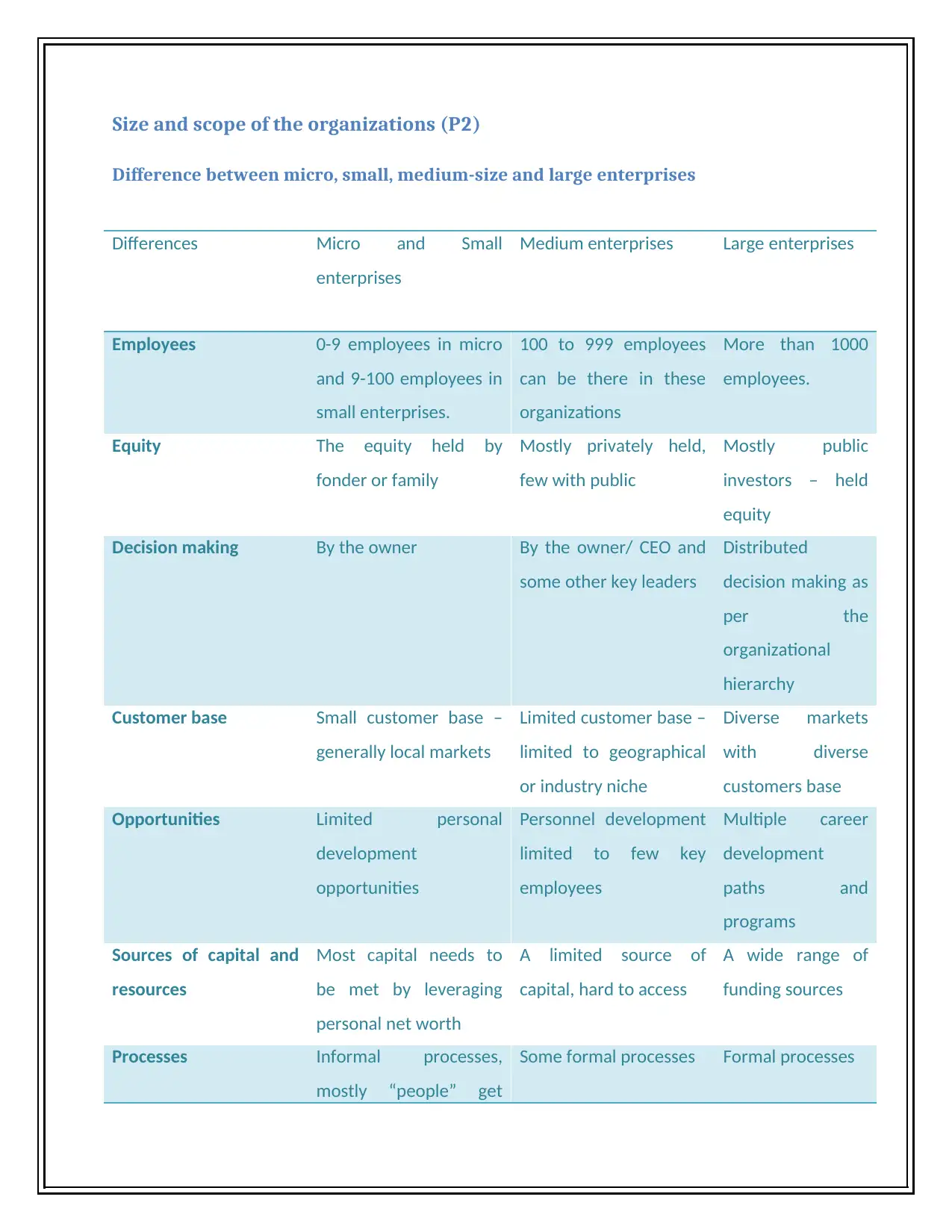
Size and scope of the organizations (P2)
Difference between micro, small, medium-size and large enterprises
Differences Micro and Small
enterprises
Medium enterprises Large enterprises
Employees 0-9 employees in micro
and 9-100 employees in
small enterprises.
100 to 999 employees
can be there in these
organizations
More than 1000
employees.
Equity The equity held by
fonder or family
Mostly privately held,
few with public
Mostly public
investors – held
equity
Decision making By the owner By the owner/ CEO and
some other key leaders
Distributed
decision making as
per the
organizational
hierarchy
Customer base Small customer base –
generally local markets
Limited customer base –
limited to geographical
or industry niche
Diverse markets
with diverse
customers base
Opportunities Limited personal
development
opportunities
Personnel development
limited to few key
employees
Multiple career
development
paths and
programs
Sources of capital and
resources
Most capital needs to
be met by leveraging
personal net worth
A limited source of
capital, hard to access
A wide range of
funding sources
Processes Informal processes,
mostly “people” get
Some formal processes Formal processes
Difference between micro, small, medium-size and large enterprises
Differences Micro and Small
enterprises
Medium enterprises Large enterprises
Employees 0-9 employees in micro
and 9-100 employees in
small enterprises.
100 to 999 employees
can be there in these
organizations
More than 1000
employees.
Equity The equity held by
fonder or family
Mostly privately held,
few with public
Mostly public
investors – held
equity
Decision making By the owner By the owner/ CEO and
some other key leaders
Distributed
decision making as
per the
organizational
hierarchy
Customer base Small customer base –
generally local markets
Limited customer base –
limited to geographical
or industry niche
Diverse markets
with diverse
customers base
Opportunities Limited personal
development
opportunities
Personnel development
limited to few key
employees
Multiple career
development
paths and
programs
Sources of capital and
resources
Most capital needs to
be met by leveraging
personal net worth
A limited source of
capital, hard to access
A wide range of
funding sources
Processes Informal processes,
mostly “people” get
Some formal processes Formal processes
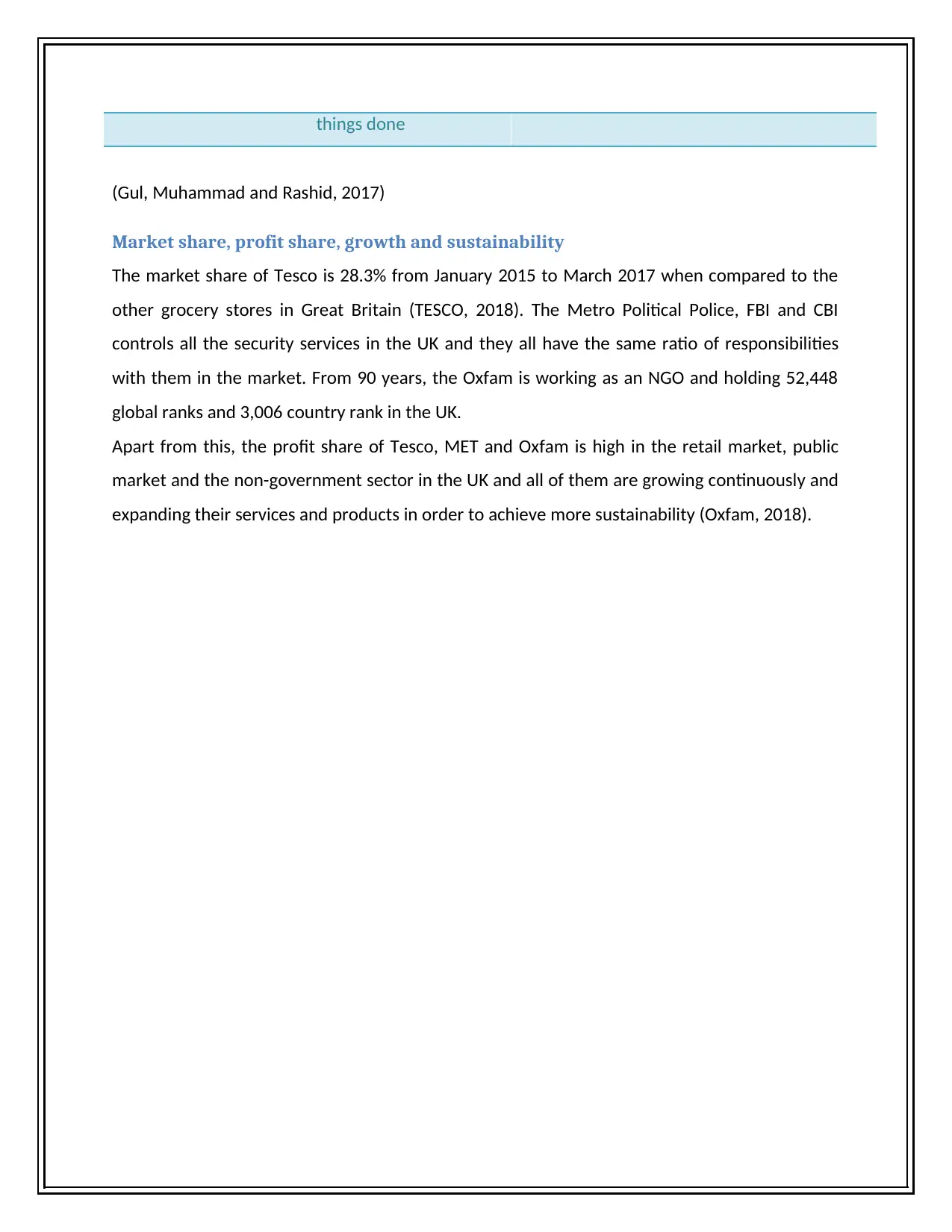
things done
(Gul, Muhammad and Rashid, 2017)
Market share, profit share, growth and sustainability
The market share of Tesco is 28.3% from January 2015 to March 2017 when compared to the
other grocery stores in Great Britain (TESCO, 2018). The Metro Political Police, FBI and CBI
controls all the security services in the UK and they all have the same ratio of responsibilities
with them in the market. From 90 years, the Oxfam is working as an NGO and holding 52,448
global ranks and 3,006 country rank in the UK.
Apart from this, the profit share of Tesco, MET and Oxfam is high in the retail market, public
market and the non-government sector in the UK and all of them are growing continuously and
expanding their services and products in order to achieve more sustainability (Oxfam, 2018).
(Gul, Muhammad and Rashid, 2017)
Market share, profit share, growth and sustainability
The market share of Tesco is 28.3% from January 2015 to March 2017 when compared to the
other grocery stores in Great Britain (TESCO, 2018). The Metro Political Police, FBI and CBI
controls all the security services in the UK and they all have the same ratio of responsibilities
with them in the market. From 90 years, the Oxfam is working as an NGO and holding 52,448
global ranks and 3,006 country rank in the UK.
Apart from this, the profit share of Tesco, MET and Oxfam is high in the retail market, public
market and the non-government sector in the UK and all of them are growing continuously and
expanding their services and products in order to achieve more sustainability (Oxfam, 2018).
⊘ This is a preview!⊘
Do you want full access?
Subscribe today to unlock all pages.

Trusted by 1+ million students worldwide
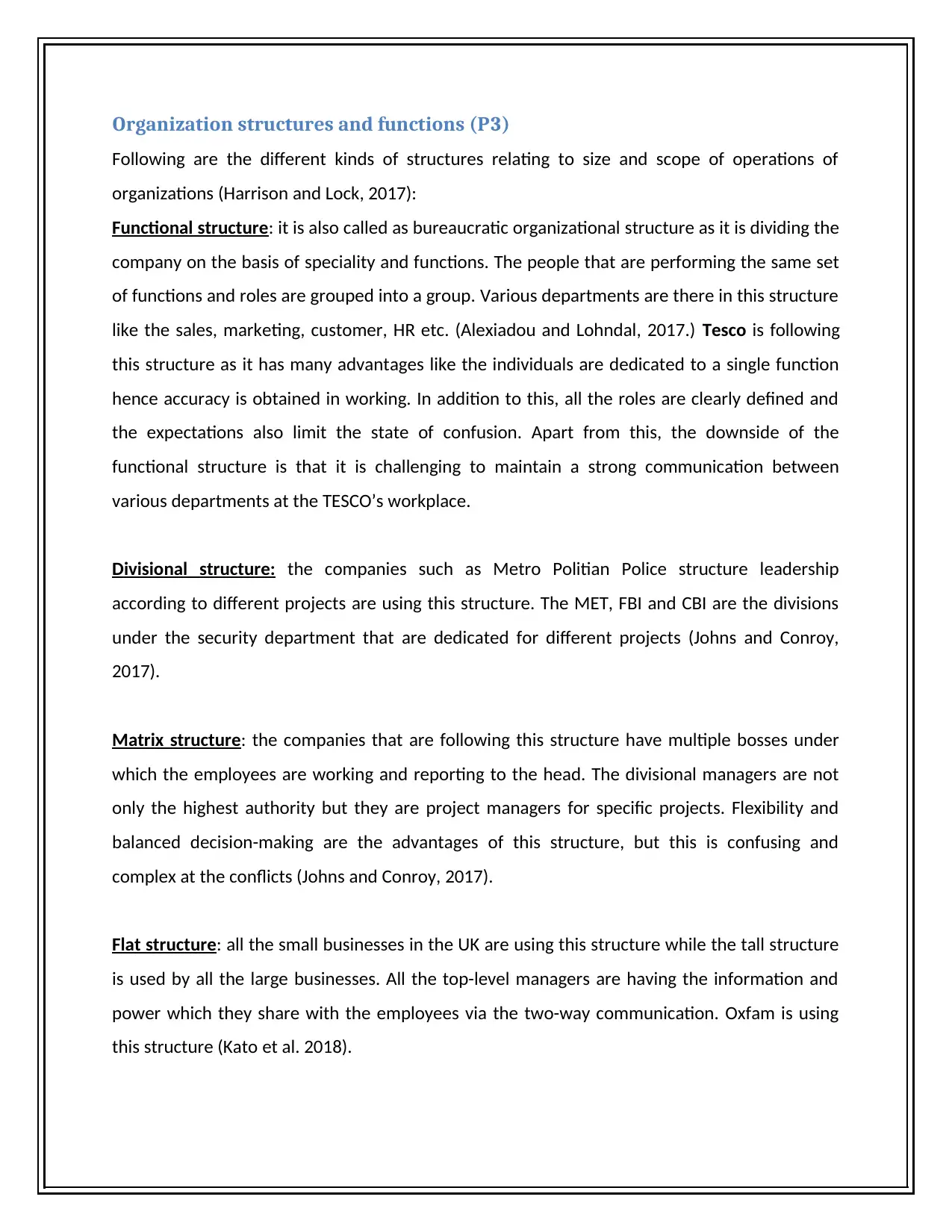
Organization structures and functions (P3)
Following are the different kinds of structures relating to size and scope of operations of
organizations (Harrison and Lock, 2017):
Functional structure: it is also called as bureaucratic organizational structure as it is dividing the
company on the basis of speciality and functions. The people that are performing the same set
of functions and roles are grouped into a group. Various departments are there in this structure
like the sales, marketing, customer, HR etc. (Alexiadou and Lohndal, 2017.) Tesco is following
this structure as it has many advantages like the individuals are dedicated to a single function
hence accuracy is obtained in working. In addition to this, all the roles are clearly defined and
the expectations also limit the state of confusion. Apart from this, the downside of the
functional structure is that it is challenging to maintain a strong communication between
various departments at the TESCO’s workplace.
Divisional structure: the companies such as Metro Politian Police structure leadership
according to different projects are using this structure. The MET, FBI and CBI are the divisions
under the security department that are dedicated for different projects (Johns and Conroy,
2017).
Matrix structure: the companies that are following this structure have multiple bosses under
which the employees are working and reporting to the head. The divisional managers are not
only the highest authority but they are project managers for specific projects. Flexibility and
balanced decision-making are the advantages of this structure, but this is confusing and
complex at the conflicts (Johns and Conroy, 2017).
Flat structure: all the small businesses in the UK are using this structure while the tall structure
is used by all the large businesses. All the top-level managers are having the information and
power which they share with the employees via the two-way communication. Oxfam is using
this structure (Kato et al. 2018).
Following are the different kinds of structures relating to size and scope of operations of
organizations (Harrison and Lock, 2017):
Functional structure: it is also called as bureaucratic organizational structure as it is dividing the
company on the basis of speciality and functions. The people that are performing the same set
of functions and roles are grouped into a group. Various departments are there in this structure
like the sales, marketing, customer, HR etc. (Alexiadou and Lohndal, 2017.) Tesco is following
this structure as it has many advantages like the individuals are dedicated to a single function
hence accuracy is obtained in working. In addition to this, all the roles are clearly defined and
the expectations also limit the state of confusion. Apart from this, the downside of the
functional structure is that it is challenging to maintain a strong communication between
various departments at the TESCO’s workplace.
Divisional structure: the companies such as Metro Politian Police structure leadership
according to different projects are using this structure. The MET, FBI and CBI are the divisions
under the security department that are dedicated for different projects (Johns and Conroy,
2017).
Matrix structure: the companies that are following this structure have multiple bosses under
which the employees are working and reporting to the head. The divisional managers are not
only the highest authority but they are project managers for specific projects. Flexibility and
balanced decision-making are the advantages of this structure, but this is confusing and
complex at the conflicts (Johns and Conroy, 2017).
Flat structure: all the small businesses in the UK are using this structure while the tall structure
is used by all the large businesses. All the top-level managers are having the information and
power which they share with the employees via the two-way communication. Oxfam is using
this structure (Kato et al. 2018).
Paraphrase This Document
Need a fresh take? Get an instant paraphrase of this document with our AI Paraphraser
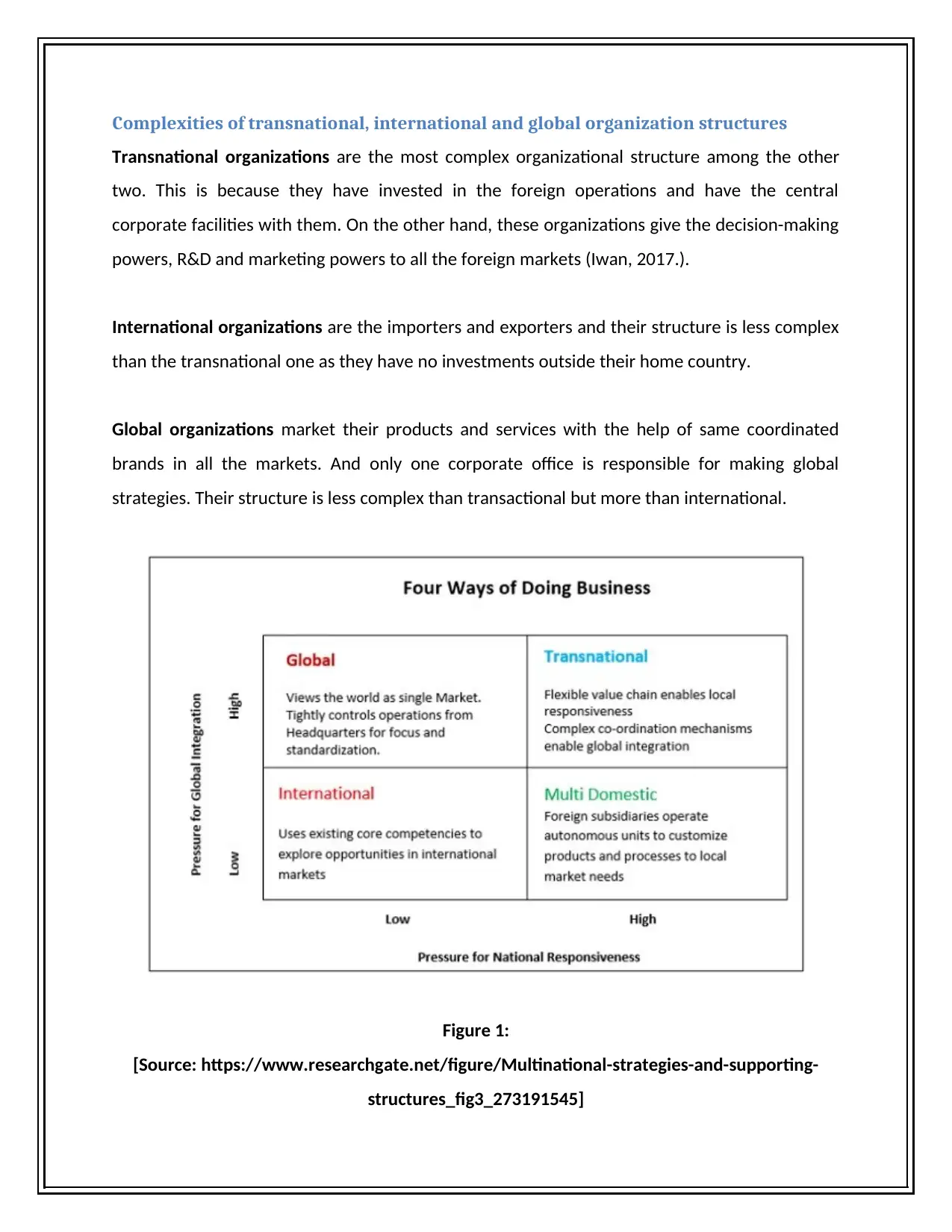
Complexities of transnational, international and global organization structures
Transnational organizations are the most complex organizational structure among the other
two. This is because they have invested in the foreign operations and have the central
corporate facilities with them. On the other hand, these organizations give the decision-making
powers, R&D and marketing powers to all the foreign markets (Iwan, 2017.).
International organizations are the importers and exporters and their structure is less complex
than the transnational one as they have no investments outside their home country.
Global organizations market their products and services with the help of same coordinated
brands in all the markets. And only one corporate office is responsible for making global
strategies. Their structure is less complex than transactional but more than international.
Figure 1:
[Source: https://www.researchgate.net/figure/Multinational-strategies-and-supporting-
structures_fig3_273191545]
Transnational organizations are the most complex organizational structure among the other
two. This is because they have invested in the foreign operations and have the central
corporate facilities with them. On the other hand, these organizations give the decision-making
powers, R&D and marketing powers to all the foreign markets (Iwan, 2017.).
International organizations are the importers and exporters and their structure is less complex
than the transnational one as they have no investments outside their home country.
Global organizations market their products and services with the help of same coordinated
brands in all the markets. And only one corporate office is responsible for making global
strategies. Their structure is less complex than transactional but more than international.
Figure 1:
[Source: https://www.researchgate.net/figure/Multinational-strategies-and-supporting-
structures_fig3_273191545]
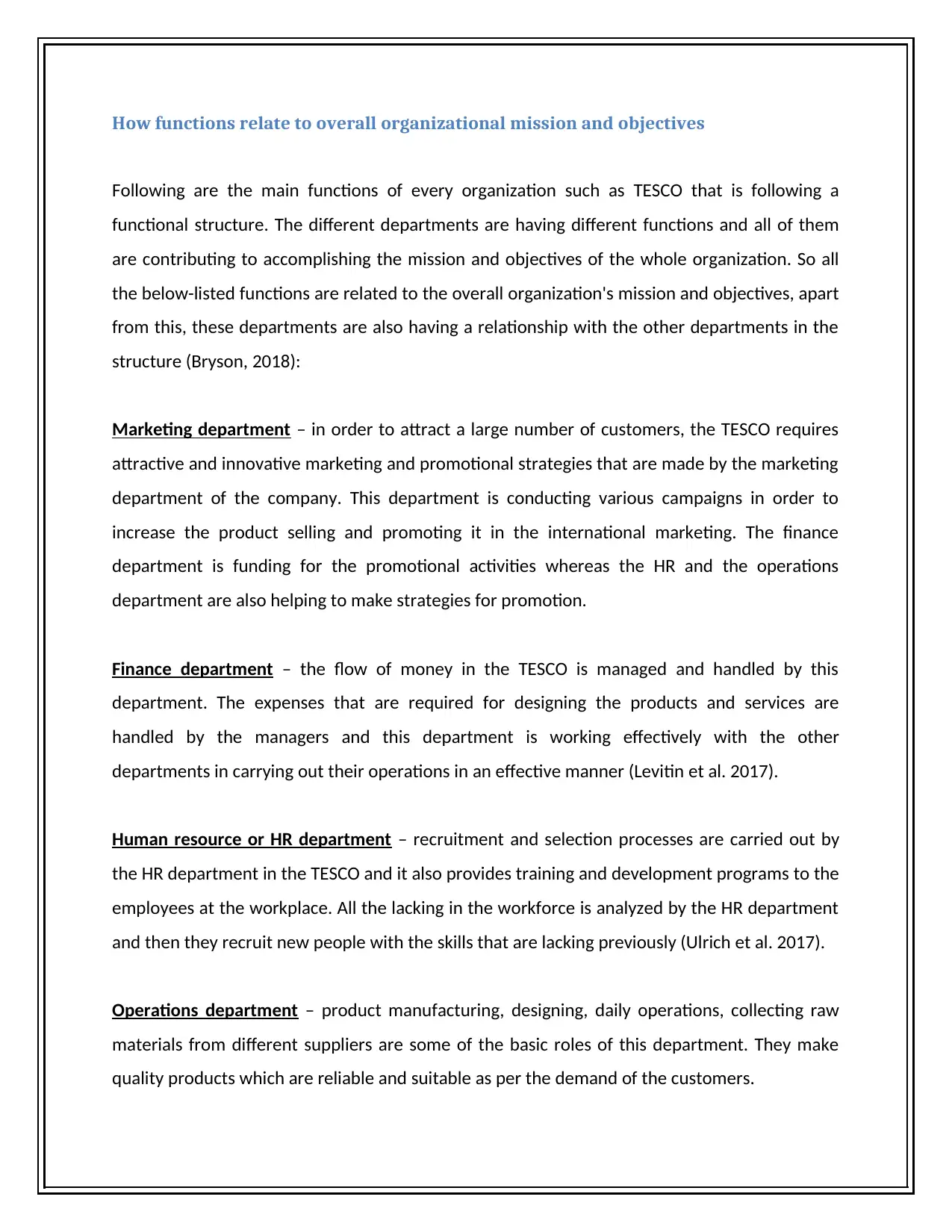
How functions relate to overall organizational mission and objectives
Following are the main functions of every organization such as TESCO that is following a
functional structure. The different departments are having different functions and all of them
are contributing to accomplishing the mission and objectives of the whole organization. So all
the below-listed functions are related to the overall organization's mission and objectives, apart
from this, these departments are also having a relationship with the other departments in the
structure (Bryson, 2018):
Marketing department – in order to attract a large number of customers, the TESCO requires
attractive and innovative marketing and promotional strategies that are made by the marketing
department of the company. This department is conducting various campaigns in order to
increase the product selling and promoting it in the international marketing. The finance
department is funding for the promotional activities whereas the HR and the operations
department are also helping to make strategies for promotion.
Finance department – the flow of money in the TESCO is managed and handled by this
department. The expenses that are required for designing the products and services are
handled by the managers and this department is working effectively with the other
departments in carrying out their operations in an effective manner (Levitin et al. 2017).
Human resource or HR department – recruitment and selection processes are carried out by
the HR department in the TESCO and it also provides training and development programs to the
employees at the workplace. All the lacking in the workforce is analyzed by the HR department
and then they recruit new people with the skills that are lacking previously (Ulrich et al. 2017).
Operations department – product manufacturing, designing, daily operations, collecting raw
materials from different suppliers are some of the basic roles of this department. They make
quality products which are reliable and suitable as per the demand of the customers.
Following are the main functions of every organization such as TESCO that is following a
functional structure. The different departments are having different functions and all of them
are contributing to accomplishing the mission and objectives of the whole organization. So all
the below-listed functions are related to the overall organization's mission and objectives, apart
from this, these departments are also having a relationship with the other departments in the
structure (Bryson, 2018):
Marketing department – in order to attract a large number of customers, the TESCO requires
attractive and innovative marketing and promotional strategies that are made by the marketing
department of the company. This department is conducting various campaigns in order to
increase the product selling and promoting it in the international marketing. The finance
department is funding for the promotional activities whereas the HR and the operations
department are also helping to make strategies for promotion.
Finance department – the flow of money in the TESCO is managed and handled by this
department. The expenses that are required for designing the products and services are
handled by the managers and this department is working effectively with the other
departments in carrying out their operations in an effective manner (Levitin et al. 2017).
Human resource or HR department – recruitment and selection processes are carried out by
the HR department in the TESCO and it also provides training and development programs to the
employees at the workplace. All the lacking in the workforce is analyzed by the HR department
and then they recruit new people with the skills that are lacking previously (Ulrich et al. 2017).
Operations department – product manufacturing, designing, daily operations, collecting raw
materials from different suppliers are some of the basic roles of this department. They make
quality products which are reliable and suitable as per the demand of the customers.
⊘ This is a preview!⊘
Do you want full access?
Subscribe today to unlock all pages.

Trusted by 1+ million students worldwide
1 out of 22
Related Documents
Your All-in-One AI-Powered Toolkit for Academic Success.
+13062052269
info@desklib.com
Available 24*7 on WhatsApp / Email
![[object Object]](/_next/static/media/star-bottom.7253800d.svg)
Unlock your academic potential
Copyright © 2020–2025 A2Z Services. All Rights Reserved. Developed and managed by ZUCOL.




